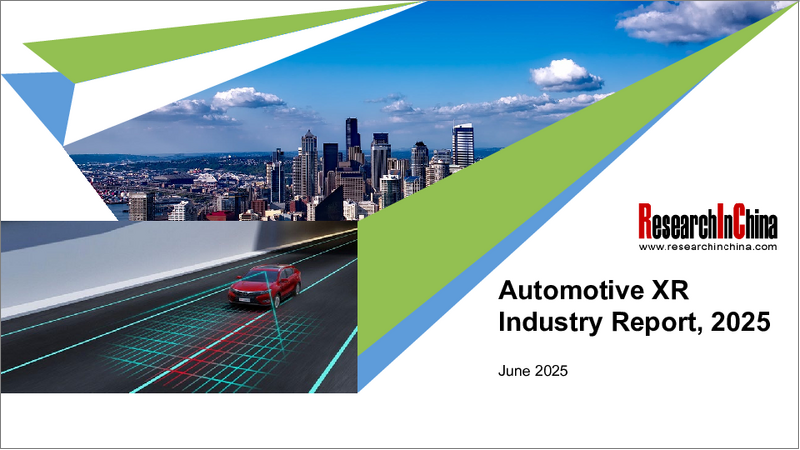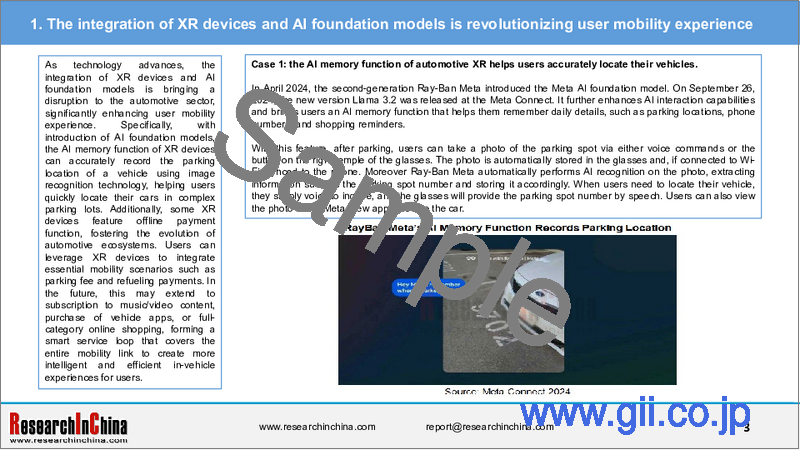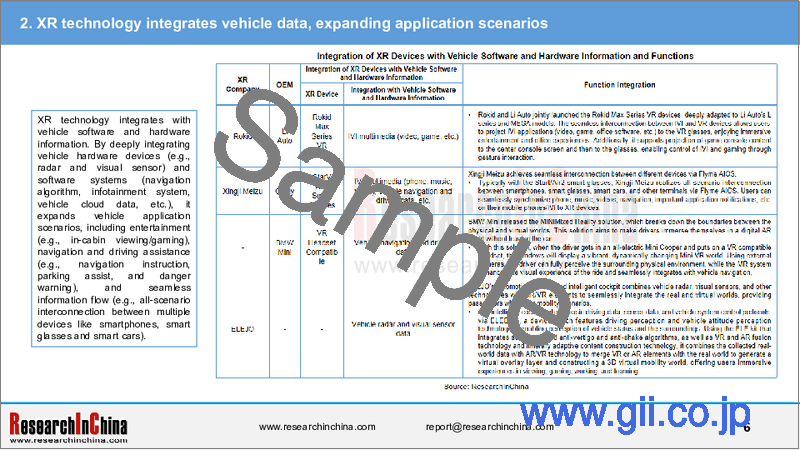|
|
市場調査レポート
商品コード
1777118
自動車用XR産業(2025年)Automotive XR Industry Report, 2025 |
||||||
|
|||||||
| 自動車用XR産業(2025年) |
|
出版日: 2025年06月02日
発行: ResearchInChina
ページ情報: 英文 161 Pages
納期: 即日から翌営業日
|
全表示
- 概要
- 目次
1. XRデバイスとAI基盤モデルの統合は、ユーザーのモビリティ体験に革命をもたらしています。
技術の進歩に伴い、XRデバイスとAI基盤モデルの統合は自動車部門に破壊をもたらし、ユーザーのモビリティ体験を大幅に向上させています。具体的には、AI基盤モデルの搭載により、XRデバイスのAIメモリ機能は、画像認識技術を使用して車両の駐車位置を正確に記録することができ、複雑な駐車場でユーザーが素早く自分の車の位置を特定するのに役立ちます。さらに、一部のXRデバイスはオフライン決済機能を備えており、自動車エコシステムの進化を促進しています。ユーザーはXRデバイスを活用して、駐車料金や給油の決済など、不可欠なモビリティシナリオを統合することができます。将来的には、音楽/動画コンテンツの購読、自動車用アプリの購入、フルカテゴリのオンラインショッピングにまで拡大し、モビリティリンク全体をカバーするスマートサービスループを形成することで、ユーザーにとってよりインテリジェントで効率的な自動車用体験を実現できるようになる可能性があります。
2. XR技術は車両データを統合し、利用シナリオを拡大します。
XR技術は、車両のソフトウェアとハードウェアの情報を統合します。車両のハードウェアデバイス(レーダーや視覚センサーなど)とソフトウェアシステム(ナビゲーションアルゴリズム、インフォテインメントシステム、車両クラウドデータなど)を深く統合することで、エンターテインメント(車内視聴/ゲームなど)、ナビゲーションと運転支援(ナビゲーション指示、駐車支援、危険警告など)、シームレスな情報フロー(スマートフォン、スマートグラス、スマートカーなど複数のデバイス間のオールシナリオ相互接続など)など、車両の利用シナリオを拡大します。
3. OEMはXR技術を展開し、市場の新たな成長余地を拡大します。
当レポートの分析結果によると、XR技術と自動車の統合はシナリオにおいてかなりの応用可能性を示している一方、自動車用XR技術はまだ黎明期にあり、市場の転換点には至っていません。また、この技術の進歩は、主に成熟度の不足、高いコスト、自動車用途におけるユーザーの受容性向上の必要性などの課題による障害にも直面しています。
このような課題に直面しながらも、OEM各社は展開に取り組み、ブレークスルーを起こす道を模索しています。2025年、GAC、FAW、Great Wall、ZeekrなどがXR関連の特許を公開しました。Li Autoはまた、2025年の募集要項の中で、シニアハードウェアプロダクトマネージャーやAIハードウェアプロダクトマネージャーなど、AI/VRスマートグラスに関連する複数の求人情報を掲載しており、これは自動車部門におけるXR技術のチーム構築と利用促進に向けた同社の大きな活動を示しています。
このことは、OEMが自動車分野におけるXR技術の応用可能性に大きな自信を持ち、その展開を加速させるために具体的な行動を起こしていることを示しています。技術が成熟し、コストが低下し、スマートモビリティ体験に対するユーザーの要求が高まるにつれて、XR技術は自動車産業変革の重要な促進要因となり、この部門に新たな成長機会を生み出すと予測されます。
当レポートでは、中国の自動車用XR産業について調査し、XRの産業チェーンと主な技術的要素の分析、コア技術と光学ディスプレイソリューションの解説、国内外の自動車用XRデバイス/ソフトウェアソリューションサプライヤーの最新の製品とソリューションなどの情報を提供しています。
目次
序文
定義
第1章 自動車用XRの概要と市場動向
- XRの分類と定義
- XRの産業チェーン
- XR向けメインストリームコアコンピューティングチップのサマリー
- 主なXR技術のサマリー
- VR/MR光学モジュールソリューションの比較
- AR光学モジュールソリューションの比較
- XRニアアイディスプレイソリューションの比較
- XRデバイスのシースルー技術ルート:光学シースルー(OST)/ビデオシースルー(VST)
- 自動車産業におけるXRのビジネス利用シナリオのサマリー
- 自動車産業におけるXRの消費者利用シナリオのサマリー
- 中国のスマートウェアラブル製品に関する政策環境
- 自動車用XR開発動向1
- 自動車用XR開発動向2
- 自動車用XR開発動向3
- 自動車用XR開発動向4
第2章 自動車用XRデバイス/ソフトウェアソリューションの主要サプライヤー
- Meta
- RayNeo
- Rokid
- XREAL
- Holoride
- ELEJO
- CATARC Intelligent Connected Technology
- Hysim Technology
第3章 OEMと関連エコシステム企業のXRレイアウト
- BMW
- Geely
- Harmony Intelligent Mobility Alliance (HIMA)
- Li Auto
- NIO
- Skyworth
- Chery
- GAC Groupの自動車用XRのレイアウト
- FAWのXRのレイアウト:スマートガラスの特許
- Great Wall MotorのXRのレイアウト:スマートガラスの特許
Automotive XR industry research: automotive XR application is still in its infancy, and some OEMs have already made forward-looking layout
The Automotive XR Industry Report, 2025, released by ResearchInChina, focuses on the automotive XR field, deconstructs the XR industry chain and key technological elements, provides a detailed interpretation of core technologies and optical display solutions, and summarizes the latest products and solutions of Chinese and foreign automotive XR device and software solution suppliers. In addition, this report offers an in-depth analysis of XR layout of OEMs and related ecosystem companies, involving OEMs' XR strategic layout, latest automotive XR products, and XR patents. Finally, it explores the status quo and trends of automotive XR development according to market dynamics.
1. The integration of XR devices and AI foundation models is revolutionizing user mobility experience.
As technology advances, the integration of XR devices and AI foundation models is bringing a disruption to the automotive sector, significantly enhancing user mobility experience. Specifically, with introduction of AI foundation models, the AI memory function of XR devices can accurately record the parking location of a vehicle using image recognition technology, helping users quickly locate their cars in complex parking lots. Additionally, some XR devices feature offline payment function, fostering the evolution of automotive ecosystems. Users can leverage XR devices to integrate essential mobility scenarios such as parking fee and refueling payments. In the future, this may extend to subscription to music/video content, purchase of vehicle apps, or full-category online shopping, forming a smart service loop that covers the entire mobility link to create more intelligent and efficient in-vehicle experiences for users.
Case 1: the AI memory function of automotive XR helps users accurately locate their vehicles.
In April 2024, the second-generation Ray-Ban Meta introduced the Meta AI foundation model. On September 26, 2024, the new version Llama 3.2 was released at the Meta Connect. It further enhances AI interaction capabilities and brings users an AI memory function that helps them remember daily details, such as parking locations, phone numbers, and shopping reminders.
With this feature, after parking, users can take a photo of the parking spot via either voice commands or the button on the right temple of the glasses. The photo is automatically stored in the glasses and, if connected to Wi-Fi, synced to the phone. Moreover Ray-Ban Meta automatically performs AI recognition on the photo, extracting information such as the parking spot number and storing it accordingly. When users need to locate their vehicle, they simply voice to inquire, and the glasses will provide the parking spot number by speech. Users can also view the photo in the Meta View app to locate the car.
Case 2: XR devices integrate payment function, expected to land in in-vehicle payment scenarios.
a.Rokid Glasses has now integrated Alipay's "AI Life Assistant" Zhi Xiao Bao, launching the innovative AR glasses payment function based on voiceprint recognition. In such scenarios as ride hailing, food ordering, or QR code scan to pay with Rokid Glasses, users only need to wake up Zhi Xiao Bao via voice command and state the amount (e.g., "Zhi Xiao Bao, pay 50 yuan"), and the system will complete identity verification through voiceprint comparison, enabling quick small-amount payments without any manual operation throughout the process.
2.On April 29, 2025, Meizu announced its official launch of the offline payment function for StarV Air2 smart glasses, and implementation of this function in Q3 this year. Users wearing StarV Air2 smart glasses only need to activate the payment function via the built-in voice assistant, utter a payment confirmation command, and voice to confirm payment details such as the amount, and they can complete the transaction effortlessly, without the need to pull out their phones or use other devices.
2. XR technology integrates vehicle data, expanding application scenarios.
XR technology integrates with vehicle software and hardware information. By deeply integrating vehicle hardware devices (e.g., radar and visual sensor) and software systems (navigation algorithm, infotainment system, vehicle cloud data, etc.), it expands vehicle application scenarios, including entertainment (e.g., in-cabin viewing/gaming), navigation and driving assistance (e.g., navigation instruction, parking assist, and danger warning), and seamless information flow (e.g., all-scenario interconnection between multiple devices like smartphones, smart glasses and smart cars).
3. OEMs deploy XR technology to expand new growth space in the market.
According to the analysis results of the report, although the integration of XR technology and vehicles demonstrates considerable application potential in scenarios, automotive XR technology is still in its infancy and has yet to reach a market tipping point. The advancement of the technology also faces obstacles, primarily due to challenges such as insufficient maturity, high costs, and the need to improve user acceptance in automotive applications.
Facing these challenges, OEMs work to deploy and seek the way to make breakthroughs. In 2025, GAC, FAW, Great Wall and Zeekr among others have disclosed XR-related patents; Li Auto also posted several job openings related to AI/VR smart glasses in its 2025 recruitment notices, including Senior Hardware Product Manager and AI Hardware Product Manager, which indicates its great efforts to build teams and promote application of XR technology in the automotive sector.
This shows that OEMs are highly confident in the application prospects of XR technology in the automotive field and are taking concrete actions to accelerate their deployment. As the technology matures, costs decline, and user demand for smart mobility experience grows, XR technology is expected to become a key driver of automotive industry transformation, creating new growth opportunities for the sector.
Table of Contents
Preface
Definitions
1 Overview of Automotive XR and Market Trends
- 1.1 Classification and Definition of XR
- 1.2 XR Industry Chain
- XR Industry Chain Map
- 1.3 Summary of Mainstream Core Computing Chips for XR
- 1.4 Summary of Key XR Technologies
- 1.5 Comparison between VR/MR Optical Module Solutions
- 1.6 Comparison between AR Optical Module Solutions
- BirdBath Optical Solution
- BirdBath Optical Solution: Suppliers' Solutions
- Summary of Optical Waveguide Technologies
- Optical Waveguide Technologies (1): Geometric Waveguide
- Optical Waveguide Technologies (2): Diffractive Waveguide - Surface Relief Grating Waveguide
- Optical Waveguide Technologies (3): Diffractive Waveguide - Volume Holographic Waveguide
- 1.7 Comparison between XR Near-Eye Display Solutions
- LCoS Display Solution
- DLP Display Solution
- LBS Display Solution
- Micro OLED Display Solution
- Micro LED Display Solution
- 1.8 XR Device See-Through Technology Route: Optical See-Through (OST) / Video See-Through (VST)
- XR Device See-Through Technology Route (1): Optical See-Through (OST)
- XR Device See-Through Technology Route (2): Video See-Through (VST)
- 1.9 Summary of Business Application Scenarios of XR in Automotive Industry
- 1.10 Summary of Consumer Application Scenarios of XR in Automotive Industry
- 1.11 Policy Environment for Smart Wearable Products in China
- 1.12 Automotive XR Development Trend 1
- 1.13 Automotive XR Development Trend 2
- Case (1)
- Case (2)
- 1.14 Automotive XR Development Trend 3
- Case (1)
- 1.15 Automotive XR Development Trend 4
- Case (1)
2 Major Automotive XR Device and Software Solution Suppliers
- 2.1 Meta
- Profile
- AI Glasses Products (1): RayBan Meta
- AI Glasses Products (2): Aria Gen 2
- AR+AI Glasses Product: Orion
- Latest VR Headset: Quest 3S
- VR Headset Device: Comparison between Quest Products
- 2.2 RayNeo
- Profile
- AI + AR Ecosystem Architecture
- Launch of New AI+AR Glasses Product: RayNeo X3 Series
- Launch of AR Glasses with Built-In Self-Developed Foundation Model and Voice Assistant RayNeo AI: RayNeo X2 (Lite)
- 2.3 Rokid
- Profile
- Operating System for Rokid AR Spatial: YodaOS-Master System Framework Diagram
- Launch of AR+AI Smart Glasses with Built-In Tongyi Qianwen Model: Rokid Glasses
- Cooperation on Smart Glasses Ecosystem
- 2.4 XREAL
- Profile
- Comparison between AR Glasses Products
- Launch of New Generation Consumer Grade AR Glasses: XREAL One
- XREAL and Google Jointly Developed AR Glasses: Project Aura
- Project Aura Adopts Google's New Android XR Operating System
- Dynamics in Automotive XR Cooperation
- 2.5 Holoride
- Profile
- Ecosystem Architecture Diagram
- Automotive XR Hardware Solution: Holoride Retrofit
- Automotive XR Software Solution: VR In-Vehicle Entertainment Application -Holoride Cinema
- To Launch Upgraded Software Suite After Restructuring, Supporting Existing Virtual Reality Formats in Vehicles
- 2.6 ELEJO
- Profile
- Automotive XR-enabled Intelligent Cockpit: ELEJO Technology Architecture
- Automotive XR-enabled Intelligent Cockpit: ELEJO Algorithm & Engine
- Automotive XR Ecosystem Collaboration and Business Model
- Automotive XR Ecosystem Collaboration Cases
- 2.7 CATARC Intelligent Connected Technology
- Profile and Automotive XR Technology Application Solutions
- Intelligent Vehicle XR Virtual Simulation R&D Service Platform
- Intelligent Vehicle XR Virtual Simulation Verification Software System
- 2.8 Hysim Technology
- Profile
- XR Technology Application - System Architecture
- mHuman-XR User Experience Virtual Prototype Verification Platform
- mHuman-XR User Experience Virtual Prototype Verification System Architecture
- mHuman-XR Business Scenarios
- NEVC Established New Energy Vehicle Application Scenario Experience Lab Based on mHuman-XR Solution
- Intelligent Cockpit Dynamic Simulation Driving Solution
- Other Automotive XR Cooperation Cases
3 XR Layout of OEMs and Related Ecosystem Companies
- 3.1 BMW
- Achieved Fully Immersive Automotive AR Glasses Experience in 2024
- Demonstrated Driving Experience Enhanced with XREAL Air 2 Glasses, and Plan to Integrate AR into IVI in the Future
- Collaborated with Meta to Explore Vehicle Tracking Systems Based on Meta Quest Pro
- Collaborated with Meta to Enable Vehicle Gaming Entertainment Based on Meta Quest Pro
- BMW Mini Launched Automotive Mixed Reality Solution
- 3.2 Geely
- Multiple Auto Brands Like Geely, Lynk & Co and Galaxy Cooperated with Xingji Meizu on Smart Glasses
- Xingji Meizu Launched New Smart Glasses Brand "STAR"
- STAR Smart Glasses Achieve Multi-Device Interconnection Based on Flyme AIOS
- Xingji Meizu's AR Smart Glasses Products (1): StarV Air2
- Xingji Meizu's AR Smart Glasses Products (2): MYVU AR Smart Glasses
- Xingji Meizu's AR Smart Glasses Products (3): MYVU Explorer Edition AR Smart Glasses
- Xingji Meizu AR Glasses' Offline Payment Function Is Available to In-Vehicle Payment Scenarios
- Xingji Meizu's XR Layout: Smart Glasses Patent
- Zeekr's XR Layout: Smart Glasses Patent
- 3.3 Harmony Intelligent Mobility Alliance (HIMA)
- Based on Harmony OS, HIMA Achieves Terminal Interconnection with Huawei Smart Glasses
- Huawei Ecosystem Strategy: Build HarmonyOS World Based on Five Major Scenarios and Innovative Technologies
- Huawei Ecosystem Strategy: 1+8+N All-Scenario Strategy
- Huawei's Smart Wearable Technology Brand: TruSense System
- Huawei AR Smart Glasses Product: Huawei Smart Glasses 2
- Huawei's XR Layout: Smart Glasses Patent
- 3.4 Li Auto
- Cooperation on Smart Glasses
- AR Smart Glasses Products: RayNeo Air 3 AR Glasses
- AR Smart Glasses Products (1): Rokid Max AR Glasses
- AR Smart Glasses Products (2): Rokid Max2 AR Glasses
- XR Layout (1): Recruiting AR/VR Smart Glasses Related Product Managers
- XR Layout (2): Smart Glasses Patent
- 3.5 NIO
- Achieve Cockpit Virtual Design and Review Based on XR Glasses
- VR Headset: NIO VR Headset
- AR Smart Glasses Product: NIO Air AR Glasses
- XR Layout: Smart Glasses Patent
- 3.6 Skyworth
- XR Product Layout
- Collaborated with Skyworth XR to Launch Sleep Aid VR Headset
- Comparison between MR/VR Headset Series
- Key Features of MR/VR Headset
- MR/VR Headset Software Algorithm: Self-Developed 6DoF Algorithm
- MR/VR Headset Software Platform SkyOS: Add Interactive 3D Scenes
- XR Layout: Smart Glasses Patent
- 3.7 Chery
- XR Layout: Released GENE Concept Car, Integrated with VR Glasses
- iCAR V23 Can Integrate with VR Glasses
- XR Layout: Smart Glasses Patent
- 3.8 GAC Group's Automotive XR Layout
- XR Layout: Smart Glasses Patent
- 3.9 FAW's XR Layout: Smart Glasses Patent
- 3.10 Great Wall Motor's XR Layout: Smart Glasses Patent





